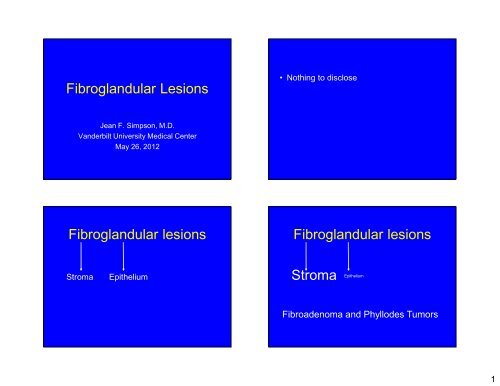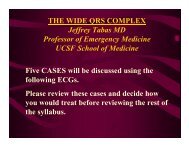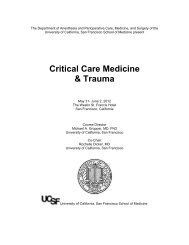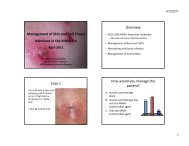Malignant Phyllodes Tumor
Malignant Phyllodes Tumor
Malignant Phyllodes Tumor
You also want an ePaper? Increase the reach of your titles
YUMPU automatically turns print PDFs into web optimized ePapers that Google loves.
Fibroglandular Lesions<br />
Jean F. Simpson, M.D.<br />
Vanderbilt University Medical Center<br />
May 26, 2012<br />
Fibroglandular lesions<br />
Stroma Epithelium<br />
• Nothing to disclose<br />
Fibroglandular lesions<br />
Stroma Epithelium<br />
Fibroadenoma and <strong>Phyllodes</strong> <strong>Tumor</strong>s<br />
1
Fibroglandular Lesions<br />
Fibroadenoma <strong>Phyllodes</strong> <strong>Tumor</strong><br />
common rare<br />
Features useful to distinguish FA<br />
from phyllodes tumor<br />
• Stromal cellularity<br />
• Stromal atypia<br />
• Stromal mitotic activity<br />
• Stromal growth relative to epithelium<br />
• Stromal interface with non-lesional<br />
breast<br />
Fibroglandular Lesions<br />
Fibroadenoma <strong>Phyllodes</strong> <strong>Tumor</strong><br />
Features NOT useful to distinguish<br />
FA from phyllodes tumor<br />
• Epithelial canalicular configuration<br />
• Character of stroma<br />
– Myxoid<br />
– Infarction<br />
• Presence of fat, smooth muscle, PASHlike<br />
or myofibroblastic areas<br />
• Presence of stromal giant cells<br />
2
Ultrasound Fibroadenoma<br />
• Cellular<br />
• Complex<br />
– Sclerosing adenosis, papillary apocrine<br />
change, epithelial calcification<br />
• Juvenile (clinical term)<br />
– Rapid growth that deforms the breast,<br />
stretches the skin in a young woman<br />
3
Myxoid stroma<br />
Fibroadenoma, sclerotic<br />
Fibroadenoma, sclerotic<br />
Fibroadenoma,<br />
myofibroblastic stroma<br />
4
Fibroadenoma,<br />
myofibroblastic stroma PASH-like<br />
Cellular fibroadenoma, lipomatous<br />
Fibroadenoma with bizzare stromal giant cells<br />
5
Fibroglandular Lesions<br />
Fibroadenoma <strong>Phyllodes</strong> <strong>Tumor</strong><br />
Cellular fibroadenoma<br />
Cellular Fibroadenoma<br />
Cellular Fibroadenoma<br />
6
Cellular Fibroadenoma Cellular Fibroadenoma<br />
Goal<br />
Appropriate<br />
(but not deforming)<br />
surgery<br />
The Spectrum of <strong>Phyllodes</strong> <strong>Tumor</strong>s<br />
Benign<br />
<strong>Malignant</strong><br />
vs fibroadenoma<br />
vs sarcoma<br />
7
Histologic classification of<br />
<strong>Phyllodes</strong> <strong>Tumor</strong><br />
• 2 tier<br />
– Low grade, high grade (implies malignant<br />
behavior for all)<br />
• 3 tier<br />
– Benign, low grade, high grade (more on<br />
malignant end of spectrum)<br />
• 3 tier<br />
– Benign, borderline, malignant (clinically<br />
relevant)<br />
<strong>Phyllodes</strong> (less than 2.5% of all<br />
fibroglandular lesions)<br />
• Benign (75%)<br />
• Borderline (20%)<br />
• <strong>Malignant</strong> (5%)<br />
• Uncommon!<br />
<strong>Phyllodes</strong> <strong>Tumor</strong><br />
• 2.5% of fibroglandular lesions<br />
• Less than 1% in referral centers<br />
• Less than 0.5% in community<br />
practices<br />
Benign <strong>Phyllodes</strong> <strong>Tumor</strong><br />
8
Benign <strong>Phyllodes</strong> <strong>Tumor</strong> Benign <strong>Phyllodes</strong> <strong>Tumor</strong><br />
Benign <strong>Phyllodes</strong> <strong>Tumor</strong> Benign <strong>Phyllodes</strong> <strong>Tumor</strong><br />
9
Benign <strong>Phyllodes</strong> <strong>Tumor</strong><br />
Benign <strong>Phyllodes</strong> <strong>Tumor</strong><br />
Benign <strong>Phyllodes</strong> <strong>Tumor</strong><br />
• Benign<br />
Differential diagnosis with<br />
fibroadenoma<br />
X<br />
• Borderline<br />
X<br />
• <strong>Malignant</strong><br />
10
Classifying <strong>Phyllodes</strong> <strong>Tumor</strong>s<br />
Benign Borderline <strong>Malignant</strong><br />
Cellularity mod mod marked<br />
Pleomorphism min mod marked<br />
Mits/ 10 hpf
Borderline <strong>Phyllodes</strong> <strong>Tumor</strong><br />
Borderline <strong>Phyllodes</strong> <strong>Tumor</strong><br />
Borderline <strong>Phyllodes</strong> <strong>Tumor</strong> Benign <strong>Phyllodes</strong> <strong>Tumor</strong><br />
Irregular margins<br />
12
Classifying <strong>Phyllodes</strong> <strong>Tumor</strong>s<br />
Benign Borderline <strong>Malignant</strong><br />
Cellularity mod mod marked<br />
Pleomorphism min mod marked<br />
Mits/ 10 hpf 10/10 HPF<br />
13
<strong>Malignant</strong> <strong>Phyllodes</strong> <strong>Tumor</strong><br />
<strong>Malignant</strong> <strong>Phyllodes</strong> <strong>Tumor</strong><br />
Liposarcomatous differentiation<br />
<strong>Malignant</strong> <strong>Phyllodes</strong> <strong>Tumor</strong><br />
osteosarcomatous differentiation<br />
<strong>Malignant</strong> <strong>Phyllodes</strong> <strong>Tumor</strong><br />
14
Classifying <strong>Phyllodes</strong> <strong>Tumor</strong>s<br />
Benign Borderline <strong>Malignant</strong><br />
Cellularity mod mod marked<br />
Pleomorphism min mod marked<br />
Mits/ 10 hpf
Clinical Behavior<br />
• Local recurrence does not equate with<br />
malignancy<br />
• <strong>Malignant</strong> PT means metastatic capability<br />
• PT often recur, but DO NOT metastasize<br />
Core Biopsy Considerations<br />
Dx: Fibroglandular lesion<br />
see comment<br />
Surgically excise<br />
Fibroglandular lesion<br />
Fibroadenoma<br />
<strong>Phyllodes</strong> <strong>Tumor</strong><br />
???<br />
Moderate to marked stromal<br />
cellularity<br />
Stromal atypia<br />
Mitoses<br />
YES NO<br />
Dx: Fibroadenoma<br />
Follow clinically or remove<br />
Clinical Management<br />
• Any can recur with inadequate margins<br />
• Rate of local recurrence related margin<br />
width<br />
• No significant role for XRT<br />
•
Which feature is NOT useful in<br />
distinguishing FA from PT<br />
1. Interface of lesion with adjacent breast<br />
2. Presence of stromal giant cells<br />
3. Stromal cellularity<br />
4. Stromal mitotic activity<br />
17

















